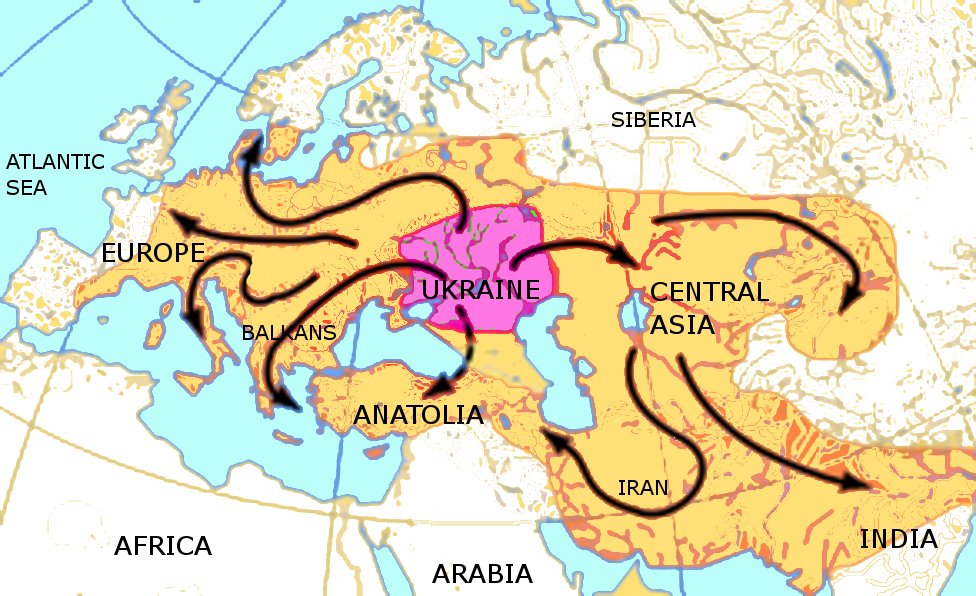Communication among humans is essential, and as we evolved, we have come to master the art of speaking. Through time and research, linguists have come to the conclusion that, because many languages from Europe and Asia share multiple similarities in vocabulary, there must have been a language from which these languages originally derived. The fact that a single language can develop into two or more different languages is due to language change.1 This language change through Europe and Asia refers to the Indo-European languages. These Indo-European languages are believed to have derived from an ancestral language known as Proto-Indo-European, which is no longer spoken.2 Because these native speakers left no evidence of writing, linguists have yet to solve when this language branched out to the various Indo-European languages we know today.

There are ten major branches to the Indo-European family of languages: Tocharian, Indo-Iranian, Hellenic, Armenian, Balto-Slavic, Albanian, Celtic, Italic, Germanic, and Anatolian. These branches also branch to other major languages, such as Russian, Polish, Spanish, German, English and many more. Words derived from the Indo-European languages are similar among each other, most commonly found in numerals from one to ten, body parts, plants, and animals.3 These findings have opened the gates for numerous researchers, including the famous philologists Sir William Jones and Franz Bopp.

Sir William Jones was an English philologist who first introduced the theory that all these languages were derived from the same language. Jones knew twenty-eight languages, which set the groundwork for his future findings. In 1786, he published The Sanskrit Language, in which he suggested that Sanskrit, Greek, and Latin shared a common root and were also related to other languages.4In 1788, he delivered a famous speech, which is considered the beginning of Indo-European language studies and comparative linguistics. Jones writes:
“The Sanskrit language, whatever be its antiquity, is of a wonderful structure; more perfect than the Greek, more copious than the Latin, and more exquisitely refined than either, yet bearing to both of them a stronger affinity, both in the roots of verbs and the forms of grammar, than could possibly have been produced by accident; so strong indeed, that no philologer could examine them all three, without believing them to have sprung from some common source, which, perhaps, no longer exists.”5
After Jones’ death, different scholars continued to investigate his findings. Franz Bopp, a German linguist, discovered the importance Sanskrit had in comparative studies of the Indo-European languages and analysed grammatical structures and compared their morphology.6 His work concentrated on tracing the origins of five different languages by focusing on their verbs. Then in 1820, he extended his studies to include grammar. Bopp’s findings resulted in the science of comparative grammar that we study today.
Although there is no literary evidence for what happened to the Proto-Indo-European native ancestors, it has been hypothesized that they migrated to different locations. As time passed, the language evolved greatly in a way that new languages began emerging, causing the original to perish. Despite the current exploration, researchers are still puzzled about the original Indo-European language, and they continue to search for answers today.

- Benjamin W. Fortson, IV, Indo-European Language and Culture: An Introduction (John Wiley & Sons, 2011), 4. ↵
- Fortson, Indo-European Language and Culture, 11. ↵
- Fortson, Indo-European Language and Culture, 41, 52, 67. ↵
- Encyclopedia of World Biography, December 2006, s.v. “William Jones Biography.” ↵
- Fortson, Indo-European Language and Culture, 9 ↵
- Franz Bopp, Analytical Comparison of the Sanskrit, Greek, Latin and Teutonic Languages, Shewing the Original Identity of Their Grammatical Structure (1820) (Amsterdam: John Benjamins Publishing, 1974), VIII). ↵



31 comments
Rodney Jones
Reading this article and the notion that all Indo-European languages evolved and shared a common ancestor was pretty thrilling for someone who finds the relationships between languages to be fascinating. It is rather unfortunate that there isn’t more proof for this incredible notion, but at least for me, it encourages people to do more research and learn more about it.
Elliot Avigael
It is so interesting to think about that the birthplace of the people that went on to create some of the world’s greatest civilizations was modern day Ukraine. I just feel as if that it is a country we wouldn’t expect that from.
According to the Torah and the old Jewish sages, Japheth, the son of Noah, was considered to be the “Father of Europe”. The part of the world gifted to him was actually said to be around the area that encompasses modern day Ukraine; and it is interpreted that Japheth’s descendants are the fathers of modern day European nations, most notable of the descendants being Togarmah (Turkey), Askhenaz (Germany), Javan (Greece), and Magog (Russia).
I loved this article. I think examining the origins of languages and peoples and being able to tie it into other subjects is so incredibly interesting.
Kimberly Rivera
Being someone who finds the connections between languages fascinating, it was quite exciting reading this article and the theory of Indo-European languages evolving and coming from one single common ancestor. While its quite disappointing that there is not enough evidence to back up this amazing theory it also allows for others to want to do research and read more about it, well at least for me.
Engelbert Madrid
It is quite unfortunate that there is not enough evidence or primary sources that would help historians understand how these Indo-European languages developed. If only there was evidence of writing from these ancestors, it would be sufficient for linguists and other experts to gain more knowledge of these groups of people.
I enjoy reading and learning the origins of languages, because it gives insight on how people are similar in the way they communicate with each other. Of course, every language is unique, but I believe people use the same skills or codes to communicate with one another. The way languages form helps identify the things that are similar and different between other languages, and that is why morphology is important in humanities.
Alexander Johnson
The premise of a single common (ancestor) language is actually really fascinating. That idea had never crossed my mind before, but it makes so much sense. Such a complicated language structure might have come from a very advanced group of people. It would be very interesting to find out what happened to these people and why they all migrated in very different directions. Many theories come to mind, like a potential war, or perhaps these people were nomadic to begin with and simply split up. Regardless, further study and discovery into these ancestors would seem to be a huge development in our understanding and study of linguistics.
Cirilio Vivenza
It’s too bad the proto-Indo-European language is long gone as finding it in writing would answer so many questions for linguists and historians from the ancient middle eastern nations all the way up to the languages of today. What evidence we have today on just the study of Indo-European words such as numbers hints at how connected our origins are in the African, Asian, and European continents.
Malleigh Ebel
I find this article and its theory of the indo-european language evolving from one common ancestor very interesting. I love the theory Sir William Jones had on how we can trace the roots of languages back as far as Sanskrit, Greek, and Latin and that he thinks they might share a common ancestor which would explain some of the similarities.
Daniel Gimena
I liked this article because, personally, what excites me the most about linguistics is analyzing its origins; where do all these languages that we know today come from?
Since now, I had heard only a little bit about Indo-European language, and it was interesting to read about the proto-indo-european languages and, specially, about the research and thesis of Sir Williams Jones. Despite the great work and research of Sir Williams, I think that it is pretty obvious that there is still a lot of research to be done on the origins of our languages.
Christopher McClinton
It is very important that we all have a good understanding of the history of language and how it has rapidly evolved throughout the centuries. And also how it is constantly continuing to change. This teaches us the importance of learning how to communicate with people through learning about other cultures and languages. Communication is what our world is based upon and is key in order to achieve anything.
Nooraldeen Aldrees
In the holy Quran, it mentions that “And one of His signs is the creation of the heavens and the earth, and the diversity of your languages and colors. Surely in this are signs for those of ˹sound˺ knowledge.” They diversity of language is considered a topic that is worthy of contemplating and thinking about according to the Quran. When I first heard the term Indo-European languages, it gives me confusion. I ask myself if we were talking about European languages, Indian languages, both languages combined, only European languages that are influenced by the Indian language, or neither. I hear this term a lot, but I never have a good grasp about it. Later in the article, it mentioned that Sanskrit language has commonality with Greek and Latin. I came to shape slightly better understanding about the established connection between the three languages. How that connection between these languages happen with all this massive geographical distance is a good question to ask and attempt to answer. By looking at the history of Alexander the Great, for example, this relationship is not impossible where Alexander stretched his empire to Northwestern India. It would make sense to assume that these armies passing through many different areas would create an evolution in how people communicate and speak. However, we rarely think of how language evolve when studying history of Greece, the roman empire, the Mongol empire, Ottoman empire, or any other significant time. I believe that looking at these stories, in terms of trying to analyze how people in these empires communicated, would move us to another level of understanding these eras..